Comprehensive SWOT Analysis of Ajinomoto Company in Malaysian Market
VerifiedAdded on 2023/05/28
|21
|4649
|366
Report
AI Summary
This report presents a detailed SWOT (Strengths, Weaknesses, Opportunities, and Threats) analysis of the Ajinomoto company, a prominent player in the food industry, particularly in Malaysia. The analysis delves into the company's internal factors, such as its established brand recognition, market leadership, strong customer base, advanced production technology, responsiveness to customers, and stakeholder engagement. It also examines the company's weaknesses, including high advertising expenditures and a strong focus on the seasonings business. Furthermore, the report identifies external opportunities for Ajinomoto, such as introducing new products, expanding abroad, acquiring smaller brands, innovating existing products, capitalizing on boosting demand in the Middle East, leveraging globalization, and implementing effective marketing strategies. The report also considers potential threats like natural disasters, increasing labor costs, evolving customer expectations, government policies, product substitution, low entry barriers, economic unpredictability, price wars, and negative consumer perception of the product's health aspects. The analysis aims to provide a comprehensive understanding of Ajinomoto's strategic position and potential for growth and sustainability in the competitive market.
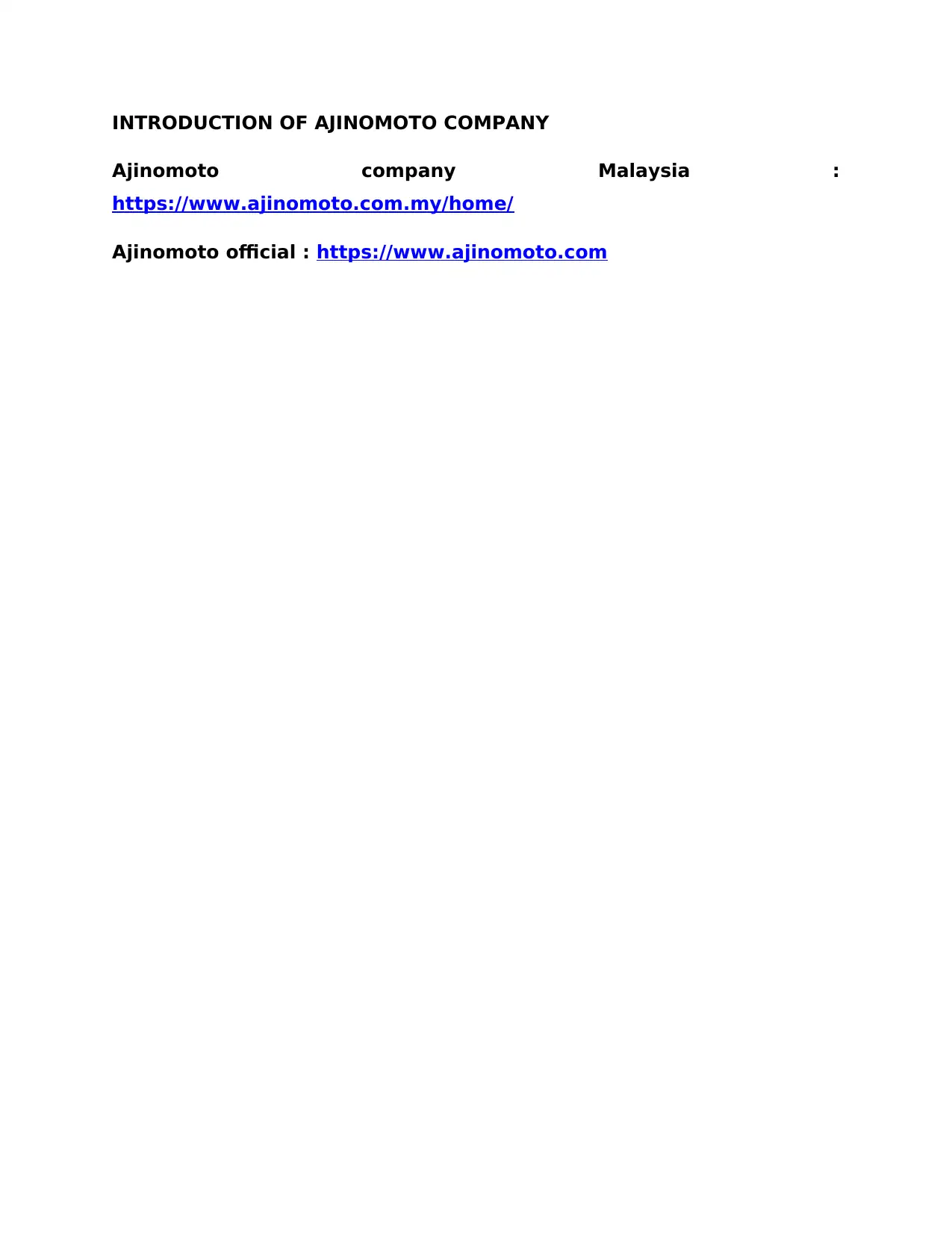
INTRODUCTION OF AJINOMOTO COMPANY
Ajinomoto company Malaysia :
https://www.ajinomoto.com.my/home/
Ajinomoto official : https://www.ajinomoto.com
Ajinomoto company Malaysia :
https://www.ajinomoto.com.my/home/
Ajinomoto official : https://www.ajinomoto.com
Paraphrase This Document
Need a fresh take? Get an instant paraphrase of this document with our AI Paraphraser
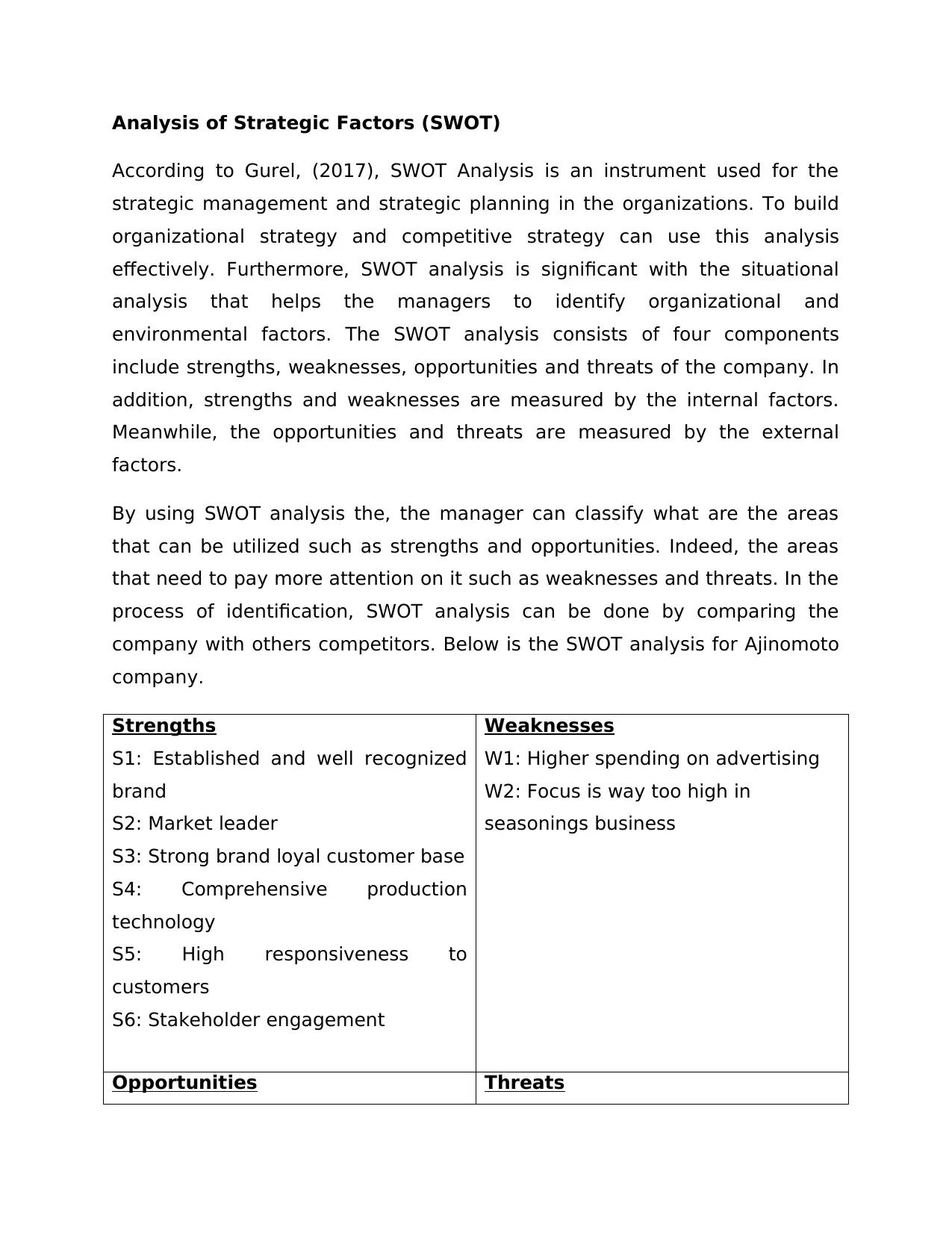
Analysis of Strategic Factors (SWOT)
According to Gurel, (2017), SWOT Analysis is an instrument used for the
strategic management and strategic planning in the organizations. To build
organizational strategy and competitive strategy can use this analysis
effectively. Furthermore, SWOT analysis is significant with the situational
analysis that helps the managers to identify organizational and
environmental factors. The SWOT analysis consists of four components
include strengths, weaknesses, opportunities and threats of the company. In
addition, strengths and weaknesses are measured by the internal factors.
Meanwhile, the opportunities and threats are measured by the external
factors.
By using SWOT analysis the, the manager can classify what are the areas
that can be utilized such as strengths and opportunities. Indeed, the areas
that need to pay more attention on it such as weaknesses and threats. In the
process of identification, SWOT analysis can be done by comparing the
company with others competitors. Below is the SWOT analysis for Ajinomoto
company.
Strengths
S1: Established and well recognized
brand
S2: Market leader
S3: Strong brand loyal customer base
S4: Comprehensive production
technology
S5: High responsiveness to
customers
S6: Stakeholder engagement
Weaknesses
W1: Higher spending on advertising
W2: Focus is way too high in
seasonings business
Opportunities Threats
According to Gurel, (2017), SWOT Analysis is an instrument used for the
strategic management and strategic planning in the organizations. To build
organizational strategy and competitive strategy can use this analysis
effectively. Furthermore, SWOT analysis is significant with the situational
analysis that helps the managers to identify organizational and
environmental factors. The SWOT analysis consists of four components
include strengths, weaknesses, opportunities and threats of the company. In
addition, strengths and weaknesses are measured by the internal factors.
Meanwhile, the opportunities and threats are measured by the external
factors.
By using SWOT analysis the, the manager can classify what are the areas
that can be utilized such as strengths and opportunities. Indeed, the areas
that need to pay more attention on it such as weaknesses and threats. In the
process of identification, SWOT analysis can be done by comparing the
company with others competitors. Below is the SWOT analysis for Ajinomoto
company.
Strengths
S1: Established and well recognized
brand
S2: Market leader
S3: Strong brand loyal customer base
S4: Comprehensive production
technology
S5: High responsiveness to
customers
S6: Stakeholder engagement
Weaknesses
W1: Higher spending on advertising
W2: Focus is way too high in
seasonings business
Opportunities Threats
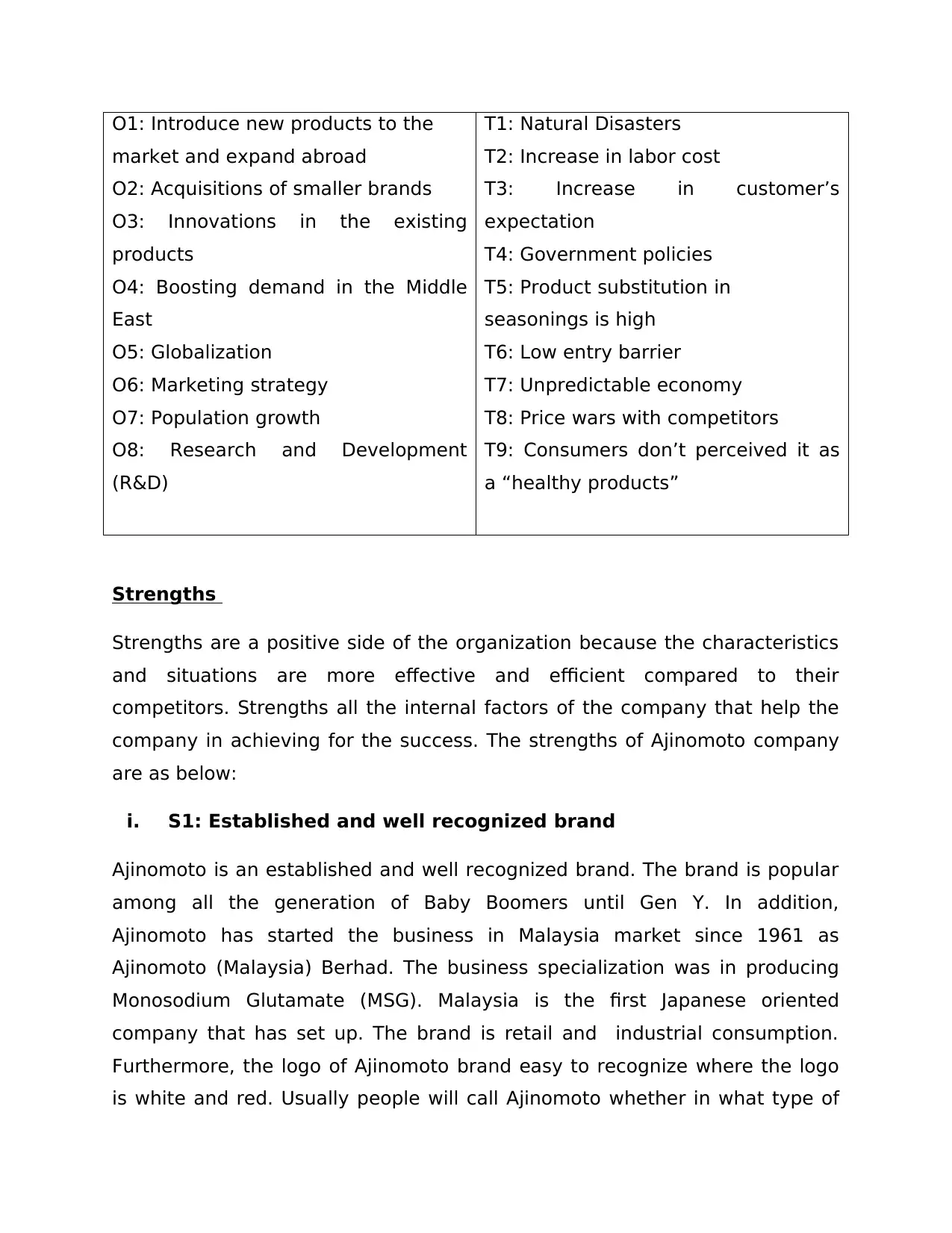
O1: Introduce new products to the
market and expand abroad
O2: Acquisitions of smaller brands
O3: Innovations in the existing
products
O4: Boosting demand in the Middle
East
O5: Globalization
O6: Marketing strategy
O7: Population growth
O8: Research and Development
(R&D)
T1: Natural Disasters
T2: Increase in labor cost
T3: Increase in customer’s
expectation
T4: Government policies
T5: Product substitution in
seasonings is high
T6: Low entry barrier
T7: Unpredictable economy
T8: Price wars with competitors
T9: Consumers don’t perceived it as
a “healthy products”
Strengths
Strengths are a positive side of the organization because the characteristics
and situations are more effective and efficient compared to their
competitors. Strengths all the internal factors of the company that help the
company in achieving for the success. The strengths of Ajinomoto company
are as below:
i. S1: Established and well recognized brand
Ajinomoto is an established and well recognized brand. The brand is popular
among all the generation of Baby Boomers until Gen Y. In addition,
Ajinomoto has started the business in Malaysia market since 1961 as
Ajinomoto (Malaysia) Berhad. The business specialization was in producing
Monosodium Glutamate (MSG). Malaysia is the first Japanese oriented
company that has set up. The brand is retail and industrial consumption.
Furthermore, the logo of Ajinomoto brand easy to recognize where the logo
is white and red. Usually people will call Ajinomoto whether in what type of
market and expand abroad
O2: Acquisitions of smaller brands
O3: Innovations in the existing
products
O4: Boosting demand in the Middle
East
O5: Globalization
O6: Marketing strategy
O7: Population growth
O8: Research and Development
(R&D)
T1: Natural Disasters
T2: Increase in labor cost
T3: Increase in customer’s
expectation
T4: Government policies
T5: Product substitution in
seasonings is high
T6: Low entry barrier
T7: Unpredictable economy
T8: Price wars with competitors
T9: Consumers don’t perceived it as
a “healthy products”
Strengths
Strengths are a positive side of the organization because the characteristics
and situations are more effective and efficient compared to their
competitors. Strengths all the internal factors of the company that help the
company in achieving for the success. The strengths of Ajinomoto company
are as below:
i. S1: Established and well recognized brand
Ajinomoto is an established and well recognized brand. The brand is popular
among all the generation of Baby Boomers until Gen Y. In addition,
Ajinomoto has started the business in Malaysia market since 1961 as
Ajinomoto (Malaysia) Berhad. The business specialization was in producing
Monosodium Glutamate (MSG). Malaysia is the first Japanese oriented
company that has set up. The brand is retail and industrial consumption.
Furthermore, the logo of Ajinomoto brand easy to recognize where the logo
is white and red. Usually people will call Ajinomoto whether in what type of
⊘ This is a preview!⊘
Do you want full access?
Subscribe today to unlock all pages.

Trusted by 1+ million students worldwide

the food seasoning. The main Ajinomoto product is Umami seasoning that
has become the essential items in almost every household.
ii. S2: Market leader
Ajinomoto is a market leader in the food seasoning or Umami seasoning.
From the figure 1, we can see that the seasoning and processed food is the
highest sales in 2017. Ajinomoto is offering the niche or specific product and
help them to be a market leader in their business. They also had the retail
and industrial product that can be useful for the both parties. Over the past
50 years, Ajinomoto has been committed to improving and develop a wide
range of product to exceed the taste of Malaysia and industrial. Furthermore,
the brand also is well known and familiar with consumers.
Figure 1: Ajinomoto Group Business Expansion (Source: Corporate Summary
Ajinomoto Co., Inc. 2018)
iii. S4: Strong brand loyal customer base
The Ajinomoto brand is a strong name and its advantages for them to have a
loyal customer. Because the product is a household product and it’s easy for
them to have a customer. The customer will keep purchasing the product
because the product is needed to consume regularly. For example, for the
food seasoning is essential for certain housewife and also for the restaurant
has become the essential items in almost every household.
ii. S2: Market leader
Ajinomoto is a market leader in the food seasoning or Umami seasoning.
From the figure 1, we can see that the seasoning and processed food is the
highest sales in 2017. Ajinomoto is offering the niche or specific product and
help them to be a market leader in their business. They also had the retail
and industrial product that can be useful for the both parties. Over the past
50 years, Ajinomoto has been committed to improving and develop a wide
range of product to exceed the taste of Malaysia and industrial. Furthermore,
the brand also is well known and familiar with consumers.
Figure 1: Ajinomoto Group Business Expansion (Source: Corporate Summary
Ajinomoto Co., Inc. 2018)
iii. S4: Strong brand loyal customer base
The Ajinomoto brand is a strong name and its advantages for them to have a
loyal customer. Because the product is a household product and it’s easy for
them to have a customer. The customer will keep purchasing the product
because the product is needed to consume regularly. For example, for the
food seasoning is essential for certain housewife and also for the restaurant
Paraphrase This Document
Need a fresh take? Get an instant paraphrase of this document with our AI Paraphraser

chef to add to their dishes. They believed that the Ajinomoto brand can give
a good tastier for the cooking. Same goes to the Ajinomoto mission were to
contribute to the world’s food and wellness and to better lives in the future.
iv. S5: Comprehensive production technology
Ajinomoto was the world leading seasoning technologies. Because, the
seasoning technology by Ajinomoto based on two fundamental scientific
strengths. First, the strength in clarifying all of the factors that comprise food
satisfaction and center on taste, flavor and texture. Second, the strength in
integrating the customer needs and preferences by applying innovative,
original materials and blending technologies. Ajinomoto has also applied the
advance technology to discover new materials and findings to expand the
portfolio of enhancers or modifiers of umami, sweetness and other taste.
Currently, they focus on the development of ‘kokumi’ which will have a
unique taste-modifying profile. In addition, this company also has several
analyses in the production technology, including the taste analysis and
control technology, flavor analysis and control technology, and texture
analysis and control technology.
v. S6: High responsiveness to customers
Ajinomoto is concern about their stakeholder in the business. One of the
stakeholder is customers. The customer is a person who helps them in
generating revenue. Without customers the business is nothing. Ajinomoto
believes that if has a good relationship with the customer will help them
sustain in the business for a long term. There are some ways how the
Ajinomoto response to their customers or consumers. For example, they
provide the customer call center. This customer call center was functioning
to help customers easily reached them. Indeed, Ajinomoto implements this
Customer Call Center to improve customer satisfaction and has established
customer service teams at five food product companies in Japan which is
first, Ajinomoto Co., Inc. Second, Ajinomoto Frozen Foods Co., Inc. Third,
a good tastier for the cooking. Same goes to the Ajinomoto mission were to
contribute to the world’s food and wellness and to better lives in the future.
iv. S5: Comprehensive production technology
Ajinomoto was the world leading seasoning technologies. Because, the
seasoning technology by Ajinomoto based on two fundamental scientific
strengths. First, the strength in clarifying all of the factors that comprise food
satisfaction and center on taste, flavor and texture. Second, the strength in
integrating the customer needs and preferences by applying innovative,
original materials and blending technologies. Ajinomoto has also applied the
advance technology to discover new materials and findings to expand the
portfolio of enhancers or modifiers of umami, sweetness and other taste.
Currently, they focus on the development of ‘kokumi’ which will have a
unique taste-modifying profile. In addition, this company also has several
analyses in the production technology, including the taste analysis and
control technology, flavor analysis and control technology, and texture
analysis and control technology.
v. S6: High responsiveness to customers
Ajinomoto is concern about their stakeholder in the business. One of the
stakeholder is customers. The customer is a person who helps them in
generating revenue. Without customers the business is nothing. Ajinomoto
believes that if has a good relationship with the customer will help them
sustain in the business for a long term. There are some ways how the
Ajinomoto response to their customers or consumers. For example, they
provide the customer call center. This customer call center was functioning
to help customers easily reached them. Indeed, Ajinomoto implements this
Customer Call Center to improve customer satisfaction and has established
customer service teams at five food product companies in Japan which is
first, Ajinomoto Co., Inc. Second, Ajinomoto Frozen Foods Co., Inc. Third,
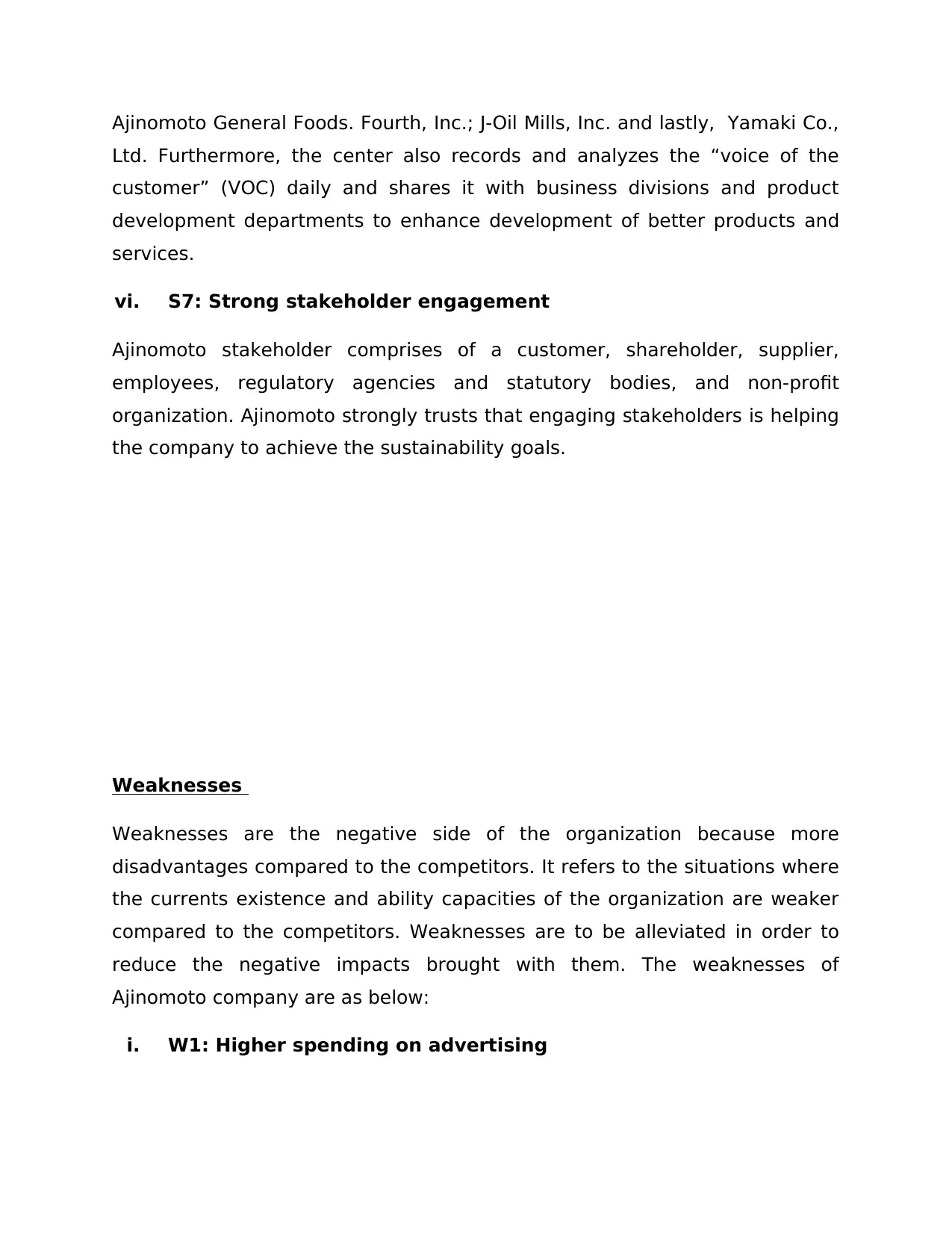
Ajinomoto General Foods. Fourth, Inc.; J-Oil Mills, Inc. and lastly, Yamaki Co.,
Ltd. Furthermore, the center also records and analyzes the “voice of the
customer” (VOC) daily and shares it with business divisions and product
development departments to enhance development of better products and
services.
vi. S7: Strong stakeholder engagement
Ajinomoto stakeholder comprises of a customer, shareholder, supplier,
employees, regulatory agencies and statutory bodies, and non-profit
organization. Ajinomoto strongly trusts that engaging stakeholders is helping
the company to achieve the sustainability goals.
Weaknesses
Weaknesses are the negative side of the organization because more
disadvantages compared to the competitors. It refers to the situations where
the currents existence and ability capacities of the organization are weaker
compared to the competitors. Weaknesses are to be alleviated in order to
reduce the negative impacts brought with them. The weaknesses of
Ajinomoto company are as below:
i. W1: Higher spending on advertising
Ltd. Furthermore, the center also records and analyzes the “voice of the
customer” (VOC) daily and shares it with business divisions and product
development departments to enhance development of better products and
services.
vi. S7: Strong stakeholder engagement
Ajinomoto stakeholder comprises of a customer, shareholder, supplier,
employees, regulatory agencies and statutory bodies, and non-profit
organization. Ajinomoto strongly trusts that engaging stakeholders is helping
the company to achieve the sustainability goals.
Weaknesses
Weaknesses are the negative side of the organization because more
disadvantages compared to the competitors. It refers to the situations where
the currents existence and ability capacities of the organization are weaker
compared to the competitors. Weaknesses are to be alleviated in order to
reduce the negative impacts brought with them. The weaknesses of
Ajinomoto company are as below:
i. W1: Higher spending on advertising
⊘ This is a preview!⊘
Do you want full access?
Subscribe today to unlock all pages.

Trusted by 1+ million students worldwide
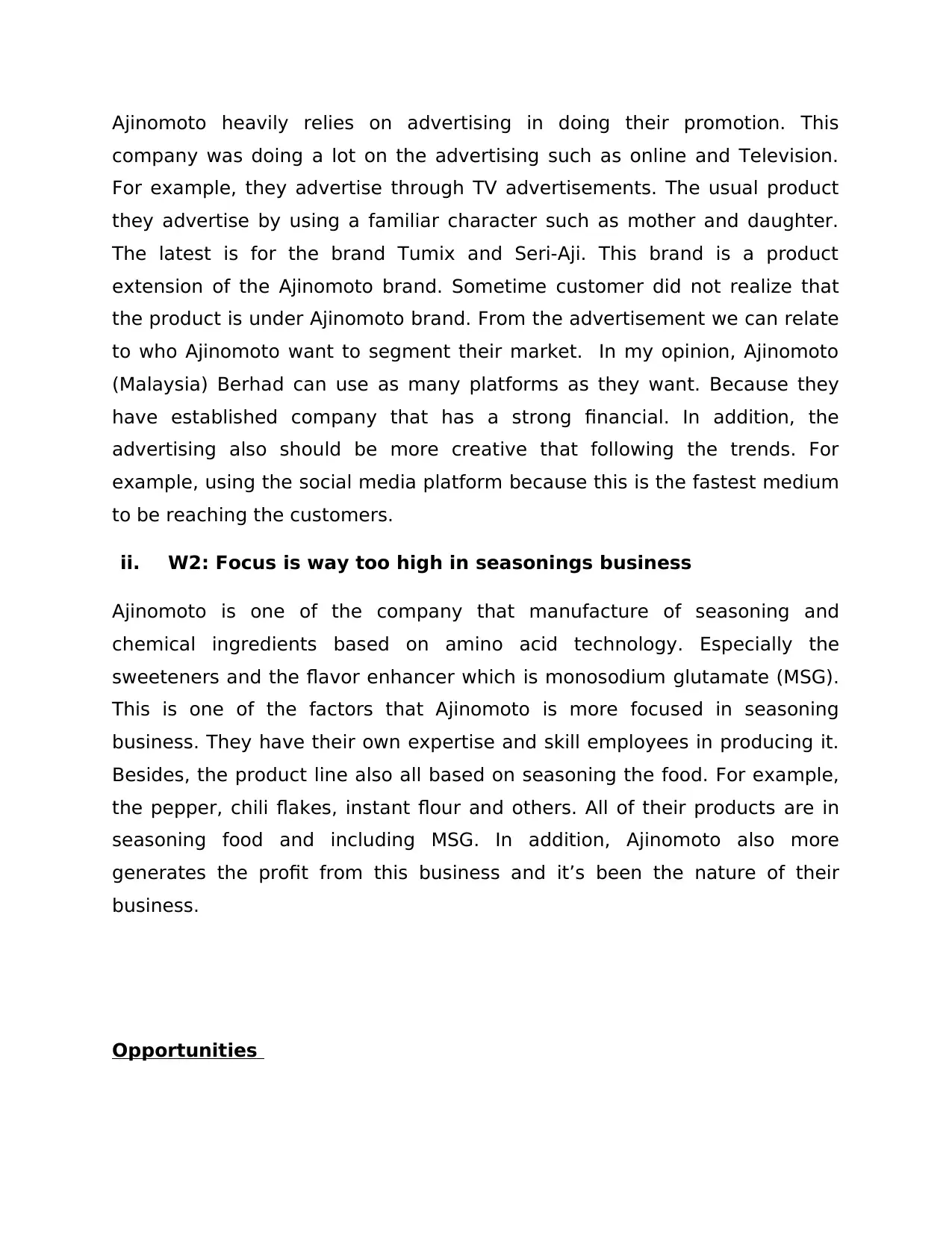
Ajinomoto heavily relies on advertising in doing their promotion. This
company was doing a lot on the advertising such as online and Television.
For example, they advertise through TV advertisements. The usual product
they advertise by using a familiar character such as mother and daughter.
The latest is for the brand Tumix and Seri-Aji. This brand is a product
extension of the Ajinomoto brand. Sometime customer did not realize that
the product is under Ajinomoto brand. From the advertisement we can relate
to who Ajinomoto want to segment their market. In my opinion, Ajinomoto
(Malaysia) Berhad can use as many platforms as they want. Because they
have established company that has a strong financial. In addition, the
advertising also should be more creative that following the trends. For
example, using the social media platform because this is the fastest medium
to be reaching the customers.
ii. W2: Focus is way too high in seasonings business
Ajinomoto is one of the company that manufacture of seasoning and
chemical ingredients based on amino acid technology. Especially the
sweeteners and the flavor enhancer which is monosodium glutamate (MSG).
This is one of the factors that Ajinomoto is more focused in seasoning
business. They have their own expertise and skill employees in producing it.
Besides, the product line also all based on seasoning the food. For example,
the pepper, chili flakes, instant flour and others. All of their products are in
seasoning food and including MSG. In addition, Ajinomoto also more
generates the profit from this business and it’s been the nature of their
business.
Opportunities
company was doing a lot on the advertising such as online and Television.
For example, they advertise through TV advertisements. The usual product
they advertise by using a familiar character such as mother and daughter.
The latest is for the brand Tumix and Seri-Aji. This brand is a product
extension of the Ajinomoto brand. Sometime customer did not realize that
the product is under Ajinomoto brand. From the advertisement we can relate
to who Ajinomoto want to segment their market. In my opinion, Ajinomoto
(Malaysia) Berhad can use as many platforms as they want. Because they
have established company that has a strong financial. In addition, the
advertising also should be more creative that following the trends. For
example, using the social media platform because this is the fastest medium
to be reaching the customers.
ii. W2: Focus is way too high in seasonings business
Ajinomoto is one of the company that manufacture of seasoning and
chemical ingredients based on amino acid technology. Especially the
sweeteners and the flavor enhancer which is monosodium glutamate (MSG).
This is one of the factors that Ajinomoto is more focused in seasoning
business. They have their own expertise and skill employees in producing it.
Besides, the product line also all based on seasoning the food. For example,
the pepper, chili flakes, instant flour and others. All of their products are in
seasoning food and including MSG. In addition, Ajinomoto also more
generates the profit from this business and it’s been the nature of their
business.
Opportunities
Paraphrase This Document
Need a fresh take? Get an instant paraphrase of this document with our AI Paraphraser
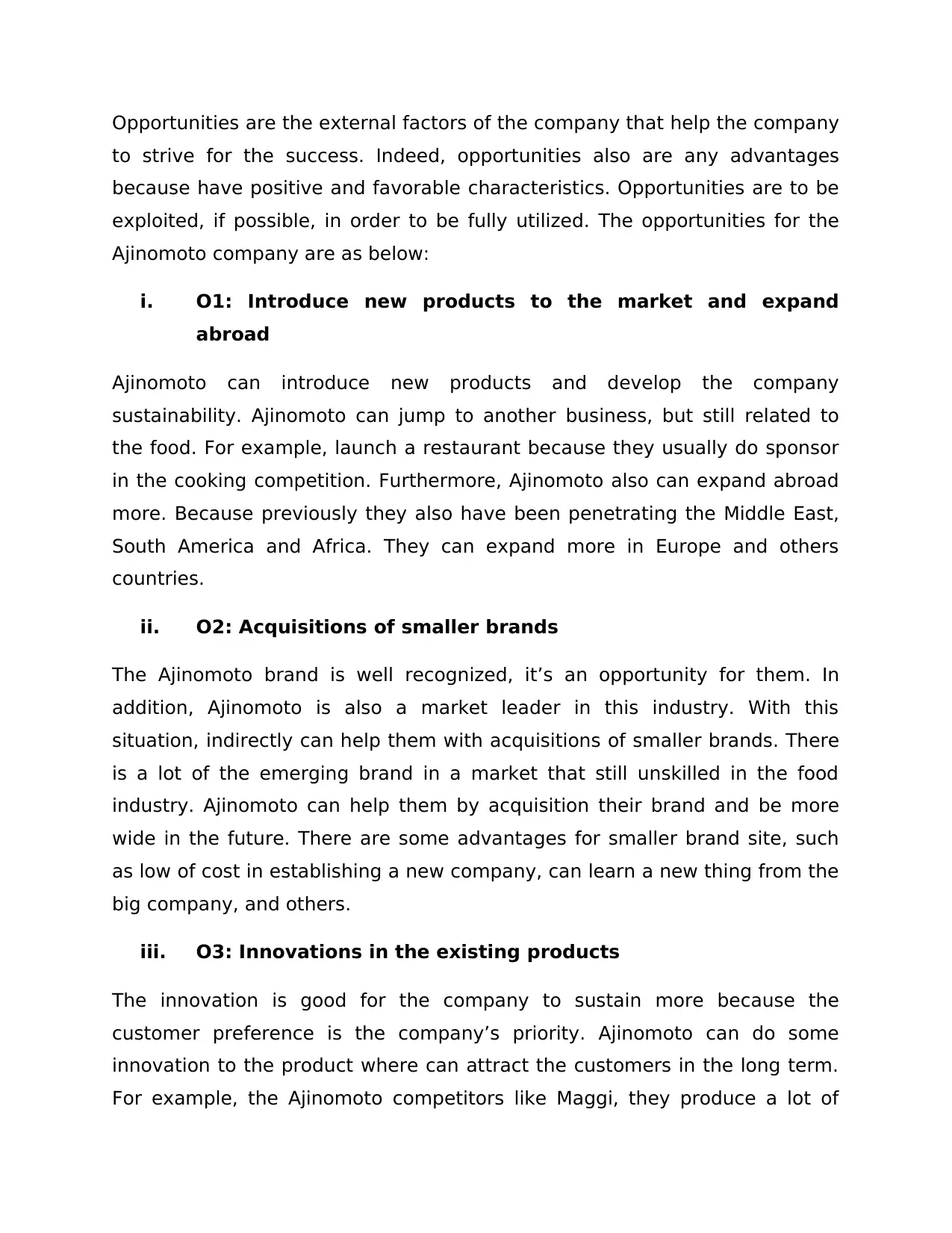
Opportunities are the external factors of the company that help the company
to strive for the success. Indeed, opportunities also are any advantages
because have positive and favorable characteristics. Opportunities are to be
exploited, if possible, in order to be fully utilized. The opportunities for the
Ajinomoto company are as below:
i. O1: Introduce new products to the market and expand
abroad
Ajinomoto can introduce new products and develop the company
sustainability. Ajinomoto can jump to another business, but still related to
the food. For example, launch a restaurant because they usually do sponsor
in the cooking competition. Furthermore, Ajinomoto also can expand abroad
more. Because previously they also have been penetrating the Middle East,
South America and Africa. They can expand more in Europe and others
countries.
ii. O2: Acquisitions of smaller brands
The Ajinomoto brand is well recognized, it’s an opportunity for them. In
addition, Ajinomoto is also a market leader in this industry. With this
situation, indirectly can help them with acquisitions of smaller brands. There
is a lot of the emerging brand in a market that still unskilled in the food
industry. Ajinomoto can help them by acquisition their brand and be more
wide in the future. There are some advantages for smaller brand site, such
as low of cost in establishing a new company, can learn a new thing from the
big company, and others.
iii. O3: Innovations in the existing products
The innovation is good for the company to sustain more because the
customer preference is the company’s priority. Ajinomoto can do some
innovation to the product where can attract the customers in the long term.
For example, the Ajinomoto competitors like Maggi, they produce a lot of
to strive for the success. Indeed, opportunities also are any advantages
because have positive and favorable characteristics. Opportunities are to be
exploited, if possible, in order to be fully utilized. The opportunities for the
Ajinomoto company are as below:
i. O1: Introduce new products to the market and expand
abroad
Ajinomoto can introduce new products and develop the company
sustainability. Ajinomoto can jump to another business, but still related to
the food. For example, launch a restaurant because they usually do sponsor
in the cooking competition. Furthermore, Ajinomoto also can expand abroad
more. Because previously they also have been penetrating the Middle East,
South America and Africa. They can expand more in Europe and others
countries.
ii. O2: Acquisitions of smaller brands
The Ajinomoto brand is well recognized, it’s an opportunity for them. In
addition, Ajinomoto is also a market leader in this industry. With this
situation, indirectly can help them with acquisitions of smaller brands. There
is a lot of the emerging brand in a market that still unskilled in the food
industry. Ajinomoto can help them by acquisition their brand and be more
wide in the future. There are some advantages for smaller brand site, such
as low of cost in establishing a new company, can learn a new thing from the
big company, and others.
iii. O3: Innovations in the existing products
The innovation is good for the company to sustain more because the
customer preference is the company’s priority. Ajinomoto can do some
innovation to the product where can attract the customers in the long term.
For example, the Ajinomoto competitors like Maggi, they produce a lot of
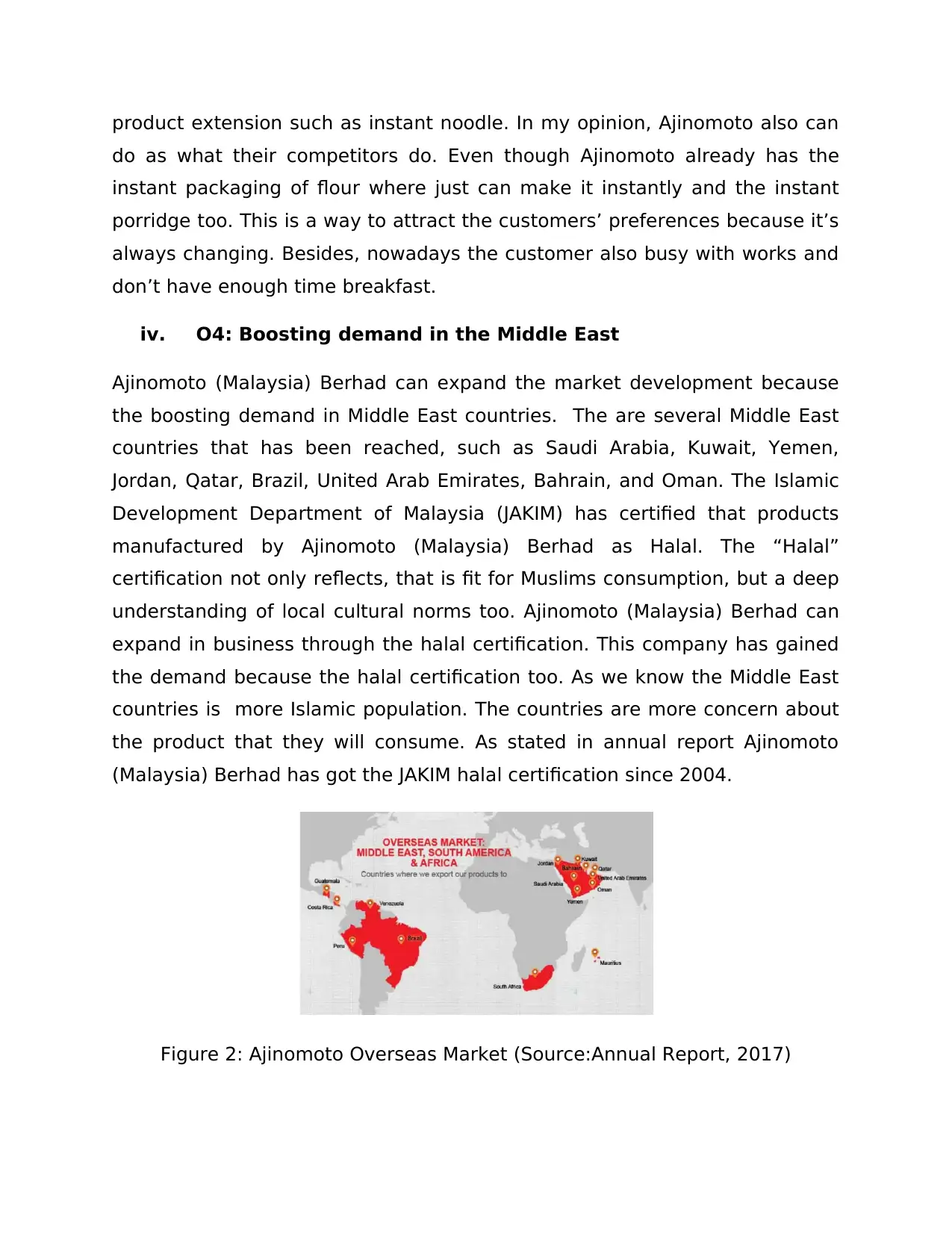
product extension such as instant noodle. In my opinion, Ajinomoto also can
do as what their competitors do. Even though Ajinomoto already has the
instant packaging of flour where just can make it instantly and the instant
porridge too. This is a way to attract the customers’ preferences because it’s
always changing. Besides, nowadays the customer also busy with works and
don’t have enough time breakfast.
iv. O4: Boosting demand in the Middle East
Ajinomoto (Malaysia) Berhad can expand the market development because
the boosting demand in Middle East countries. The are several Middle East
countries that has been reached, such as Saudi Arabia, Kuwait, Yemen,
Jordan, Qatar, Brazil, United Arab Emirates, Bahrain, and Oman. The Islamic
Development Department of Malaysia (JAKIM) has certified that products
manufactured by Ajinomoto (Malaysia) Berhad as Halal. The “Halal”
certification not only reflects, that is fit for Muslims consumption, but a deep
understanding of local cultural norms too. Ajinomoto (Malaysia) Berhad can
expand in business through the halal certification. This company has gained
the demand because the halal certification too. As we know the Middle East
countries is more Islamic population. The countries are more concern about
the product that they will consume. As stated in annual report Ajinomoto
(Malaysia) Berhad has got the JAKIM halal certification since 2004.
Figure 2: Ajinomoto Overseas Market (Source:Annual Report, 2017)
do as what their competitors do. Even though Ajinomoto already has the
instant packaging of flour where just can make it instantly and the instant
porridge too. This is a way to attract the customers’ preferences because it’s
always changing. Besides, nowadays the customer also busy with works and
don’t have enough time breakfast.
iv. O4: Boosting demand in the Middle East
Ajinomoto (Malaysia) Berhad can expand the market development because
the boosting demand in Middle East countries. The are several Middle East
countries that has been reached, such as Saudi Arabia, Kuwait, Yemen,
Jordan, Qatar, Brazil, United Arab Emirates, Bahrain, and Oman. The Islamic
Development Department of Malaysia (JAKIM) has certified that products
manufactured by Ajinomoto (Malaysia) Berhad as Halal. The “Halal”
certification not only reflects, that is fit for Muslims consumption, but a deep
understanding of local cultural norms too. Ajinomoto (Malaysia) Berhad can
expand in business through the halal certification. This company has gained
the demand because the halal certification too. As we know the Middle East
countries is more Islamic population. The countries are more concern about
the product that they will consume. As stated in annual report Ajinomoto
(Malaysia) Berhad has got the JAKIM halal certification since 2004.
Figure 2: Ajinomoto Overseas Market (Source:Annual Report, 2017)
⊘ This is a preview!⊘
Do you want full access?
Subscribe today to unlock all pages.

Trusted by 1+ million students worldwide
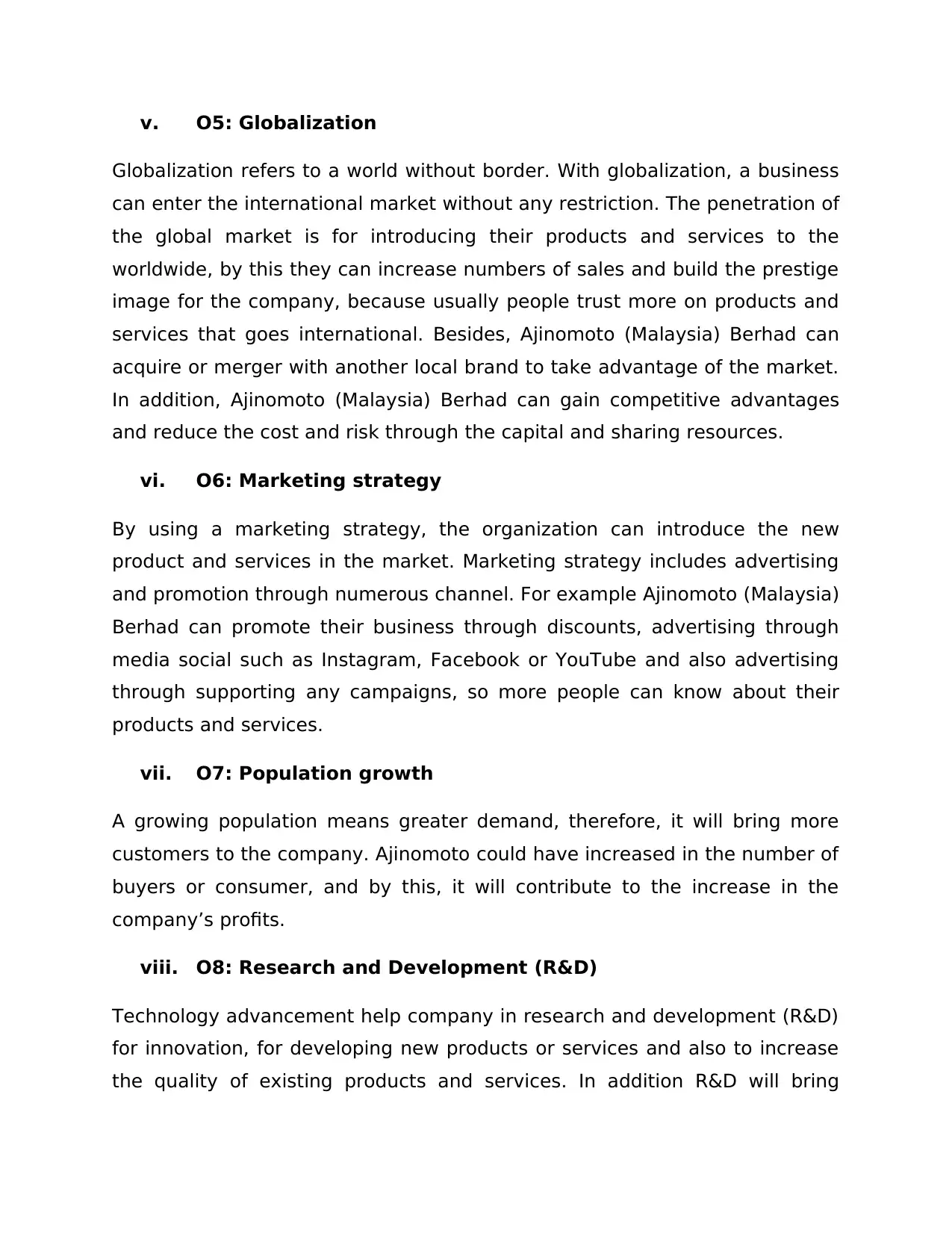
v. O5: Globalization
Globalization refers to a world without border. With globalization, a business
can enter the international market without any restriction. The penetration of
the global market is for introducing their products and services to the
worldwide, by this they can increase numbers of sales and build the prestige
image for the company, because usually people trust more on products and
services that goes international. Besides, Ajinomoto (Malaysia) Berhad can
acquire or merger with another local brand to take advantage of the market.
In addition, Ajinomoto (Malaysia) Berhad can gain competitive advantages
and reduce the cost and risk through the capital and sharing resources.
vi. O6: Marketing strategy
By using a marketing strategy, the organization can introduce the new
product and services in the market. Marketing strategy includes advertising
and promotion through numerous channel. For example Ajinomoto (Malaysia)
Berhad can promote their business through discounts, advertising through
media social such as Instagram, Facebook or YouTube and also advertising
through supporting any campaigns, so more people can know about their
products and services.
vii. O7: Population growth
A growing population means greater demand, therefore, it will bring more
customers to the company. Ajinomoto could have increased in the number of
buyers or consumer, and by this, it will contribute to the increase in the
company’s profits.
viii. O8: Research and Development (R&D)
Technology advancement help company in research and development (R&D)
for innovation, for developing new products or services and also to increase
the quality of existing products and services. In addition R&D will bring
Globalization refers to a world without border. With globalization, a business
can enter the international market without any restriction. The penetration of
the global market is for introducing their products and services to the
worldwide, by this they can increase numbers of sales and build the prestige
image for the company, because usually people trust more on products and
services that goes international. Besides, Ajinomoto (Malaysia) Berhad can
acquire or merger with another local brand to take advantage of the market.
In addition, Ajinomoto (Malaysia) Berhad can gain competitive advantages
and reduce the cost and risk through the capital and sharing resources.
vi. O6: Marketing strategy
By using a marketing strategy, the organization can introduce the new
product and services in the market. Marketing strategy includes advertising
and promotion through numerous channel. For example Ajinomoto (Malaysia)
Berhad can promote their business through discounts, advertising through
media social such as Instagram, Facebook or YouTube and also advertising
through supporting any campaigns, so more people can know about their
products and services.
vii. O7: Population growth
A growing population means greater demand, therefore, it will bring more
customers to the company. Ajinomoto could have increased in the number of
buyers or consumer, and by this, it will contribute to the increase in the
company’s profits.
viii. O8: Research and Development (R&D)
Technology advancement help company in research and development (R&D)
for innovation, for developing new products or services and also to increase
the quality of existing products and services. In addition R&D will bring
Paraphrase This Document
Need a fresh take? Get an instant paraphrase of this document with our AI Paraphraser
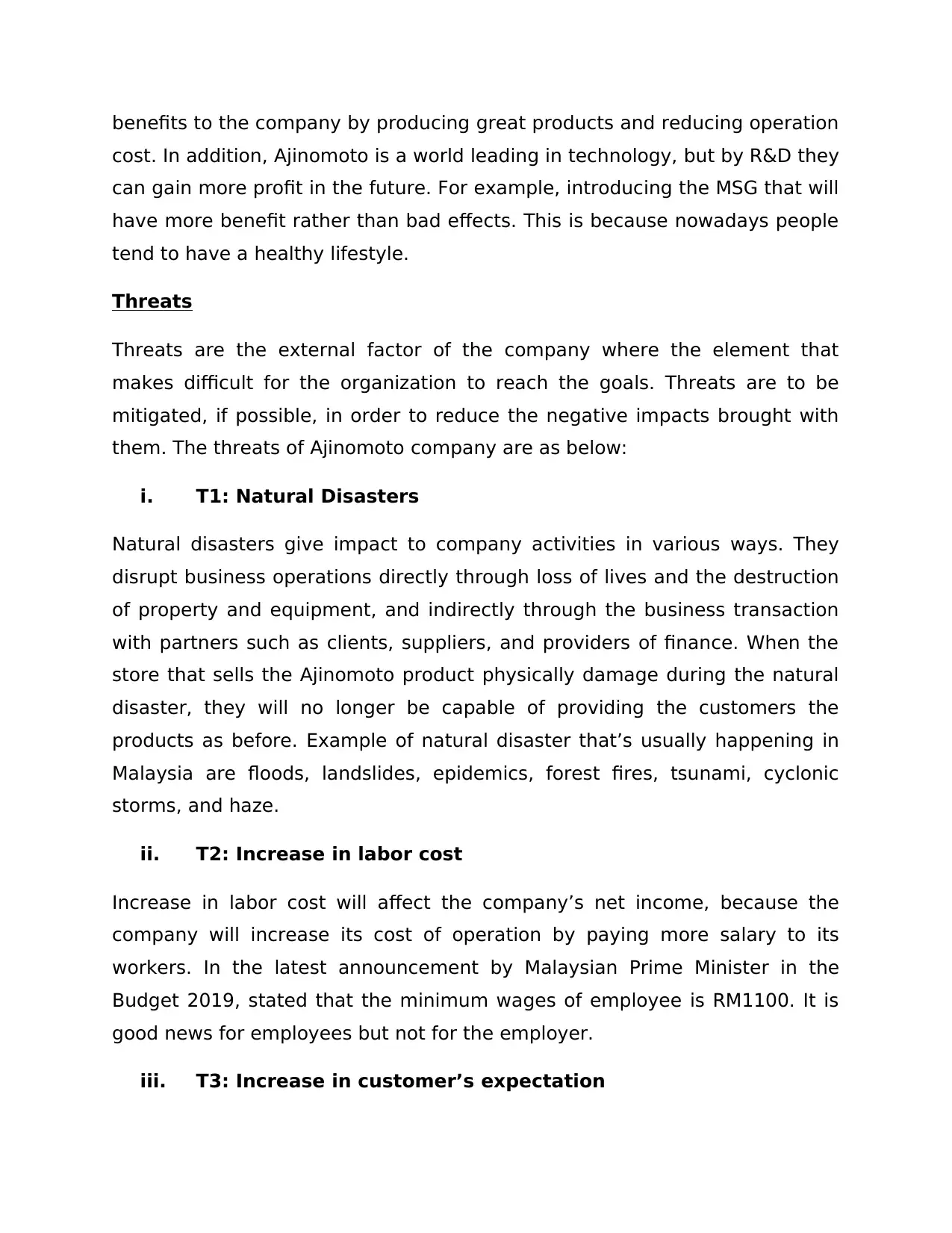
benefits to the company by producing great products and reducing operation
cost. In addition, Ajinomoto is a world leading in technology, but by R&D they
can gain more profit in the future. For example, introducing the MSG that will
have more benefit rather than bad effects. This is because nowadays people
tend to have a healthy lifestyle.
Threats
Threats are the external factor of the company where the element that
makes difficult for the organization to reach the goals. Threats are to be
mitigated, if possible, in order to reduce the negative impacts brought with
them. The threats of Ajinomoto company are as below:
i. T1: Natural Disasters
Natural disasters give impact to company activities in various ways. They
disrupt business operations directly through loss of lives and the destruction
of property and equipment, and indirectly through the business transaction
with partners such as clients, suppliers, and providers of finance. When the
store that sells the Ajinomoto product physically damage during the natural
disaster, they will no longer be capable of providing the customers the
products as before. Example of natural disaster that’s usually happening in
Malaysia are floods, landslides, epidemics, forest fires, tsunami, cyclonic
storms, and haze.
ii. T2: Increase in labor cost
Increase in labor cost will affect the company’s net income, because the
company will increase its cost of operation by paying more salary to its
workers. In the latest announcement by Malaysian Prime Minister in the
Budget 2019, stated that the minimum wages of employee is RM1100. It is
good news for employees but not for the employer.
iii. T3: Increase in customer’s expectation
cost. In addition, Ajinomoto is a world leading in technology, but by R&D they
can gain more profit in the future. For example, introducing the MSG that will
have more benefit rather than bad effects. This is because nowadays people
tend to have a healthy lifestyle.
Threats
Threats are the external factor of the company where the element that
makes difficult for the organization to reach the goals. Threats are to be
mitigated, if possible, in order to reduce the negative impacts brought with
them. The threats of Ajinomoto company are as below:
i. T1: Natural Disasters
Natural disasters give impact to company activities in various ways. They
disrupt business operations directly through loss of lives and the destruction
of property and equipment, and indirectly through the business transaction
with partners such as clients, suppliers, and providers of finance. When the
store that sells the Ajinomoto product physically damage during the natural
disaster, they will no longer be capable of providing the customers the
products as before. Example of natural disaster that’s usually happening in
Malaysia are floods, landslides, epidemics, forest fires, tsunami, cyclonic
storms, and haze.
ii. T2: Increase in labor cost
Increase in labor cost will affect the company’s net income, because the
company will increase its cost of operation by paying more salary to its
workers. In the latest announcement by Malaysian Prime Minister in the
Budget 2019, stated that the minimum wages of employee is RM1100. It is
good news for employees but not for the employer.
iii. T3: Increase in customer’s expectation
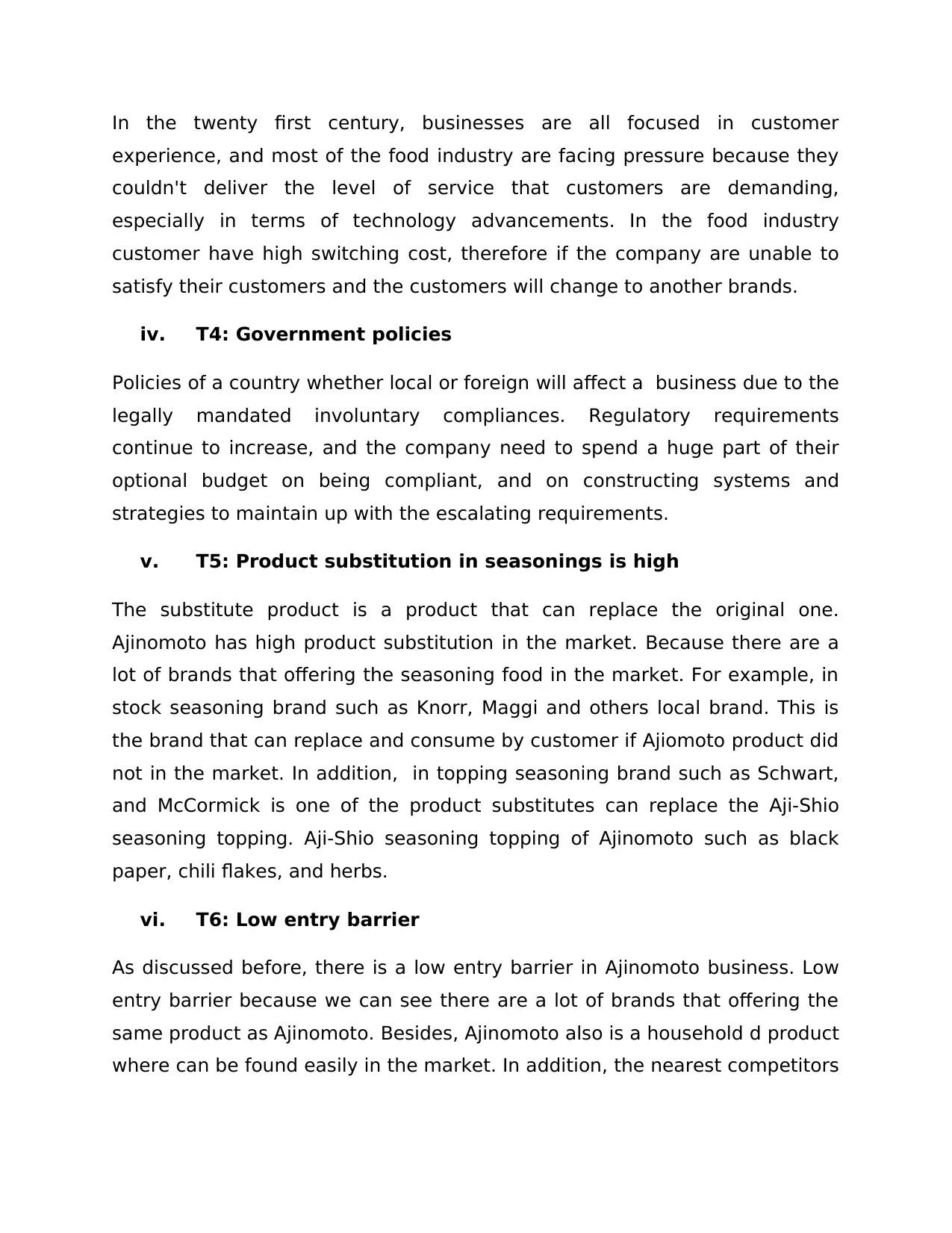
In the twenty first century, businesses are all focused in customer
experience, and most of the food industry are facing pressure because they
couldn't deliver the level of service that customers are demanding,
especially in terms of technology advancements. In the food industry
customer have high switching cost, therefore if the company are unable to
satisfy their customers and the customers will change to another brands.
iv. T4: Government policies
Policies of a country whether local or foreign will affect a business due to the
legally mandated involuntary compliances. Regulatory requirements
continue to increase, and the company need to spend a huge part of their
optional budget on being compliant, and on constructing systems and
strategies to maintain up with the escalating requirements.
v. T5: Product substitution in seasonings is high
The substitute product is a product that can replace the original one.
Ajinomoto has high product substitution in the market. Because there are a
lot of brands that offering the seasoning food in the market. For example, in
stock seasoning brand such as Knorr, Maggi and others local brand. This is
the brand that can replace and consume by customer if Ajiomoto product did
not in the market. In addition, in topping seasoning brand such as Schwart,
and McCormick is one of the product substitutes can replace the Aji-Shio
seasoning topping. Aji-Shio seasoning topping of Ajinomoto such as black
paper, chili flakes, and herbs.
vi. T6: Low entry barrier
As discussed before, there is a low entry barrier in Ajinomoto business. Low
entry barrier because we can see there are a lot of brands that offering the
same product as Ajinomoto. Besides, Ajinomoto also is a household d product
where can be found easily in the market. In addition, the nearest competitors
experience, and most of the food industry are facing pressure because they
couldn't deliver the level of service that customers are demanding,
especially in terms of technology advancements. In the food industry
customer have high switching cost, therefore if the company are unable to
satisfy their customers and the customers will change to another brands.
iv. T4: Government policies
Policies of a country whether local or foreign will affect a business due to the
legally mandated involuntary compliances. Regulatory requirements
continue to increase, and the company need to spend a huge part of their
optional budget on being compliant, and on constructing systems and
strategies to maintain up with the escalating requirements.
v. T5: Product substitution in seasonings is high
The substitute product is a product that can replace the original one.
Ajinomoto has high product substitution in the market. Because there are a
lot of brands that offering the seasoning food in the market. For example, in
stock seasoning brand such as Knorr, Maggi and others local brand. This is
the brand that can replace and consume by customer if Ajiomoto product did
not in the market. In addition, in topping seasoning brand such as Schwart,
and McCormick is one of the product substitutes can replace the Aji-Shio
seasoning topping. Aji-Shio seasoning topping of Ajinomoto such as black
paper, chili flakes, and herbs.
vi. T6: Low entry barrier
As discussed before, there is a low entry barrier in Ajinomoto business. Low
entry barrier because we can see there are a lot of brands that offering the
same product as Ajinomoto. Besides, Ajinomoto also is a household d product
where can be found easily in the market. In addition, the nearest competitors
⊘ This is a preview!⊘
Do you want full access?
Subscribe today to unlock all pages.

Trusted by 1+ million students worldwide
1 out of 21
Related Documents
Your All-in-One AI-Powered Toolkit for Academic Success.
+13062052269
info@desklib.com
Available 24*7 on WhatsApp / Email
![[object Object]](/_next/static/media/star-bottom.7253800d.svg)
Unlock your academic potential
Copyright © 2020–2026 A2Z Services. All Rights Reserved. Developed and managed by ZUCOL.




